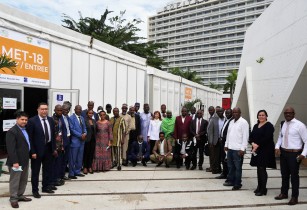West African representatives from the ministries of planning and finance, environment, and other stakeholders had gathered in Abidjan on 5-6 May 2022 for a capacity-building workshop on addressing land degradation and ecosystem restoration
The workshop was a precursor to the UN Convention to Combat Desertification conference, being held in Abidjan from 9 to 20 May. The two-day sessions focused on financing opportunities that have the potential to deliver transformative projects and programs to boost the Great Green Wall initiative in West Africa.
The African Development Bank’s Africa Climate Change Fund contributed to the workshop, developed by the UN Convention to Combat Desertification, in collaboration with several technical and financing partners.
Halting and reversing land degradation can transform the land from being a source of greenhouse gas emissions to a sink by increasing carbon stocks in soils and vegetation. Land degradation neutrality aims to balance anticipated losses in land-based natural capital and associated ecosystem functions and services with measures that avoid and reduce land degradation and produce alternative gains through land restoration and sustainable land management approaches.
Laouali Garba, manager for agriculture research, production, and sustainability at the African Development Bank, stated, “The Bank supports African countries in finding solutions for the sustainable management of natural resources to enhance the resilience of populations to the adverse effects of climate change and variability.”
Since the launch of the Bank’s Feed Africa strategy in 2015, more than 74 million people have benefited from access to improved agricultural and sustainable land management technologies. The Technologies for African Agricultural Transformation (TAAT) programme has provided 11 million farmers in 29 African countries with proven agricultural technologies, Garba continued.
“As the champion of resource mobilisation to accelerate the implementation of the Great Green Wall Initiative Priority Investment Plan (2021-2030), the African Development Bank welcomes this partnership with the Global Mechanism for the UN Convention to Combat Desertification,” Garba said.
Cathrine Mutambirwa, the program coordinator of land degradation neutrality and land restoration at the Global Mechanism, said, “We work with partners to improve the capacity to design transformative land-based interventions to build resilience and improve rural livelihoods. With the African Development Bank and other partners, we complement each other well to move the projects quickly.”
Land-based transformative projects and programmes can target a wide range of funding sources, by combining public, private, and blended financial resources, including the Global Environment Facility, the Green Climate Fund, the Adaptation Fund, and other financing mechanisms from multilateral and bilateral banks, like the Land Degradation Neutrality Fund.
The African Development Bank, as an implementing agency and accredited entity to the Global Environment Facility, Green Climate Fund, and the Climate Investment Funds, is co-financing projects that contribute to addressing land degradation in Africa.
Yasmina Oodally, an environmental specialist at the World Bank, explained how the World Bank supports the Great Green Wall, with future land restoration projects targeting policy and institutional reforms designed to empower local communities, especially women. The World Bank committed US$5.6bn through ongoing and new projects in the Great Green Wall countries.
Sarah Toumi, program management officer of the Great Green Wall initiative, said, “The Pan-African Initiative of the Great Green Wall is a nature-based solution to the complex challenges facing humanity and a compelling symbol of what is possible if we work together to protect and restore our planet. It is one piece in the puzzle in providing genuine alternatives for people increasingly working together to stop the drivers of land degradation and increase rehabilitation of degraded lands.”





